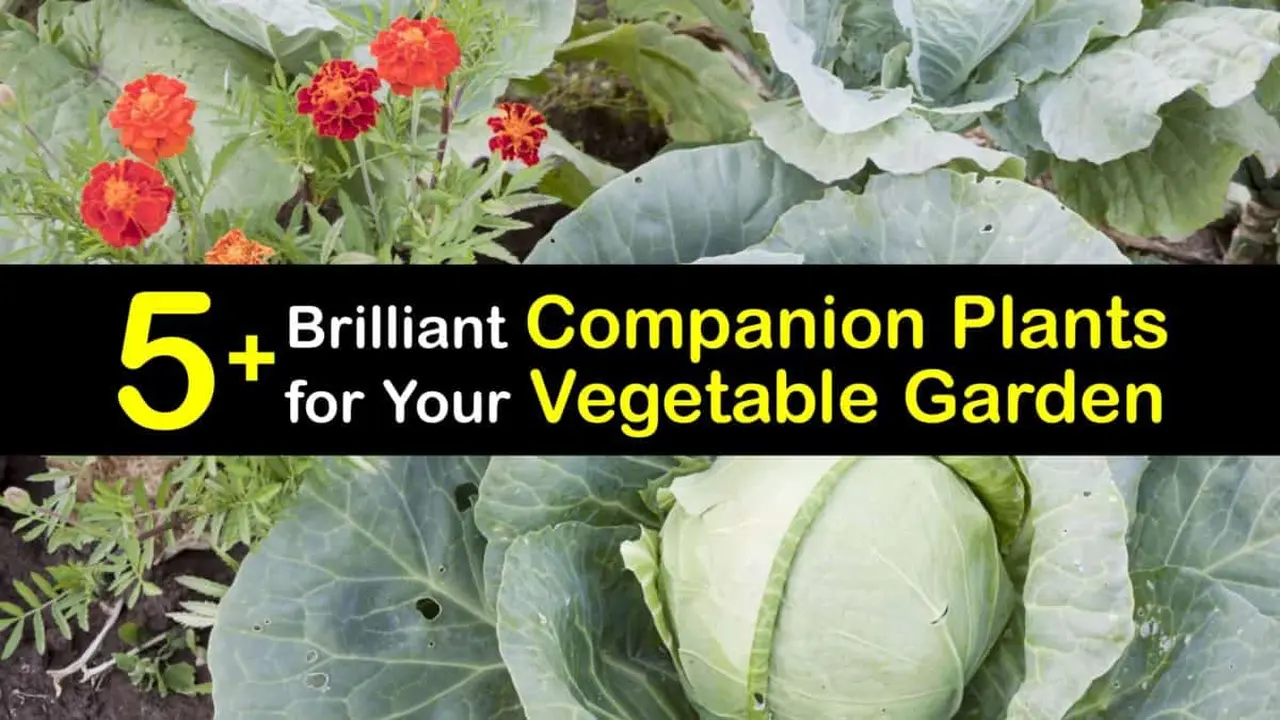Companion Planting Benefits for Vegetables
Explore the benefits of companion planting for your vegetable garden. Learn which plants thrive together.

Companion Planting Benefits for Vegetables
Understanding Companion Planting Basics
Hey there, fellow green thumbs! Ever wondered why some plants just seem to get along famously in the garden, while others act like grumpy neighbors? That's the magic of companion planting! It's an age-old gardening technique where you strategically place different plants near each other to help them grow better, deter pests, attract beneficial insects, and even improve soil health. Think of it as creating a little ecosystem in your backyard where everyone helps each other out. It's not just about throwing seeds in the ground; it's about creating a harmonious community.
This practice isn't some new-fangled trend; it's been around for centuries, passed down through generations of farmers and gardeners. Indigenous cultures, for instance, famously used the 'Three Sisters' method – planting corn, beans, and squash together. The corn provides a stalk for the beans to climb, the beans fix nitrogen in the soil for the corn, and the squash leaves shade the ground, suppressing weeds and retaining moisture. Pretty clever, right? It's all about understanding the natural synergies between different plant species.
Key Benefits of Companion Planting for Your Vegetable Garden
Natural Pest Control and Deterrence
One of the biggest wins with companion planting is its ability to naturally keep those pesky garden invaders at bay. Instead of reaching for chemical sprays, you can use plants as your first line of defense. For example, marigolds are superstars at deterring nematodes and other harmful soil pests. Plant them around your tomatoes or other susceptible veggies, and watch them work their magic. Another great example is planting garlic or onions near roses to ward off aphids. The strong scent of these alliums confuses pests, making it harder for them to find their target plants. It's like a natural camouflage system for your veggies!
Here are a few more pest-deterring plant pairings:
- Nasturtiums: These pretty flowers are often called 'trap crops' because aphids absolutely love them. Plant them away from your main crops, and the aphids will flock to the nasturtiums, leaving your other plants alone.
- Mint: While you need to be careful as mint can be invasive, planting it in containers near cabbage or tomatoes can deter cabbage moths and spider mites.
- Rosemary: This aromatic herb is excellent for repelling carrot rust flies and cabbage moths. Plant it near carrots, beans, or cabbage.
- Radishes: Believe it or not, radishes can act as a trap crop for flea beetles, drawing them away from more valuable crops like spinach or kale.
Attracting Beneficial Insects and Pollinators
It's not just about keeping the bad guys out; it's also about inviting the good guys in! Many companion plants are fantastic at attracting beneficial insects like ladybugs, lacewings, and hoverflies, which are natural predators of common garden pests. Think of them as your garden's personal security team. Dill, cilantro, and fennel, for instance, are magnets for predatory wasps and hoverflies. These insects will happily munch on aphids, caterpillars, and other destructive pests, keeping your garden healthy without you lifting a finger (well, almost!).
And let's not forget the pollinators! Bees, butterflies, and other pollinators are essential for many vegetable crops to produce fruit. Planting flowers like borage, calendula, or sunflowers near your fruiting vegetables (like tomatoes, peppers, or squash) will encourage these busy workers to visit your garden, leading to better yields. More bees mean more veggies – it's a win-win!
Improving Soil Health and Nutrient Uptake
Some plants are like natural soil engineers, improving the very ground your vegetables grow in. Legumes, such as beans and peas, are famous for their ability to 'fix' nitrogen from the air into the soil. Nitrogen is a crucial nutrient for leafy growth, so planting beans near nitrogen-hungry plants like corn or leafy greens can give them a significant boost. It's like having a natural fertilizer factory right in your garden!
Other plants have deep taproots that can break up compacted soil, bringing up nutrients from deeper layers that shallow-rooted plants can't reach. Daikon radishes, for example, are often used as a cover crop for this very purpose. When they decompose, they leave behind channels that improve drainage and aeration, making it easier for other plant roots to grow. It's all about creating a healthy, living soil ecosystem.
Providing Shade and Support
Companion planting can also offer physical benefits. Taller plants can provide much-needed shade for more delicate, shade-loving plants during the hottest parts of the day. For instance, planting lettuce or spinach (which can bolt in intense heat) in the shade of taller corn or sunflowers can extend their growing season. This is especially useful in warmer climates where the sun can be relentless.
And remember the 'Three Sisters' example? Corn provides a natural trellis for climbing beans, saving you the hassle and expense of building separate supports. This kind of symbiotic relationship makes gardening more efficient and often more aesthetically pleasing too. It's about maximizing your space and resources in a smart way.
Popular Companion Planting Pairings for Your Vegetable Garden
Tomatoes and Their Best Friends
Tomatoes are garden darlings, and they have some great companions! Basil is a classic pairing; it's said to improve the flavor of tomatoes and deter tomato hornworms and flies. Marigolds, as mentioned, are excellent for nematode control. Carrots, onions, and parsley also make good neighbors. However, keep tomatoes away from brassicas (like broccoli and cabbage) and corn, as they can stunt each other's growth.
Corn, Beans, and Squash: The Three Sisters
This is the ultimate companion planting success story. Corn provides a sturdy stalk for beans to climb, beans fix nitrogen for the corn and squash, and squash leaves shade the soil, suppressing weeds and retaining moisture. It's a perfect example of how plants can work together to create a thriving mini-ecosystem. If you have the space, definitely give this trio a try!
Cabbage Family (Broccoli, Cabbage, Kale) Companions
These leafy greens are often targeted by cabbage worms and other pests. Aromatic herbs like rosemary, mint (in containers!), and dill can help deter these pests. Chamomile and dill are also said to improve the flavor and growth of brassicas. Avoid planting them near strawberries or tomatoes.
Carrots and Their Helpful Neighbors
Carrots benefit from companions like rosemary, which deters carrot rust flies. Lettuce and radishes can also be good neighbors, as they have shallow roots and won't compete for nutrients. Avoid planting carrots near dill or fennel, as they can attract spider mites and stunt carrot growth.
Peppers and Their Perfect Partners
Peppers generally get along well with most garden vegetables. Carrots, onions, and basil are good companions. Marigolds can help with nematode control. Avoid planting peppers near beans, as they can stunt each other's growth.
Products to Enhance Your Companion Planting Efforts
While companion planting is largely about working with nature, a few tools and products can make your life easier and your garden more successful. These aren't strictly necessary, but they can definitely give you an edge, especially if you're just starting out or want to optimize your space.
Seed Starting Kits for Diverse Planting
To get a head start on your companion planting, especially with herbs or flowers that you want to intersperse with your vegetables, a good seed starting kit is invaluable. This allows you to germinate seeds indoors in a controlled environment before transplanting them into your garden beds.
- Burpee Seed Starting Kit: This is a popular choice for beginners. It typically includes peat pots, a growing medium, and a clear dome for humidity. It's great for starting a variety of companion plants like basil, marigolds, or dill.
- Jiffy Peat Pellets: These are super convenient. Just add water, and they expand into a ready-to-plant medium. They're excellent for starting individual companion plants that you'll later place strategically.
- Hydrofarm Jump Start Seedling Heat Mat: For those trickier seeds or if you want faster germination, a heat mat can make a huge difference. It provides consistent warmth from below, encouraging quicker sprouting for all your companion plant seeds.
Soil Amendments for Optimal Growth
Even with nitrogen-fixing beans, healthy soil is the foundation of a successful garden. Using good quality compost or organic fertilizers can boost the overall health of your plants, making them more resilient and better able to benefit from companion planting.
- Espoma Organic Garden-tone: This is an all-purpose organic fertilizer that provides a balanced blend of nutrients. It's great for giving all your companion plants a good start and maintaining their vigor throughout the season.
- Worm Castings (e.g., Uncle Jim's Worm Farm): These are nature's perfect fertilizer! Worm castings are rich in beneficial microbes and nutrients, improving soil structure and plant health. Sprinkle them around your companion plants for an extra boost.
- Compost Tumbler (e.g., Yimby Tumbler Composter): If you're serious about soil health, making your own compost is the way to go. A compost tumbler makes the process easy and efficient, providing you with a continuous supply of nutrient-rich material for your companion planting beds.
Pest Monitoring Tools (Even with Companions)
While companion planting is fantastic for pest deterrence, it's always a good idea to keep an eye on your garden. Early detection of any pest issues means you can address them before they become a major problem, even with your companion plants doing their job.
- Yellow Sticky Traps (e.g., Garsum Sticky Traps): These are simple, non-toxic traps that attract and catch flying insects like whiteflies, fungus gnats, and aphids. Place them strategically near your companion plants to monitor pest activity.
- Garden Magnifying Glass/Jeweler's Loupe: Sometimes, pests are tiny! A good magnifying glass helps you inspect leaves and stems closely to identify any early signs of trouble. This is crucial for identifying specific pests that your companion plants might not deter.
Watering Systems for Healthy Plant Growth
Proper watering is key for all plants, including your companion plants. Consistent moisture helps them thrive and perform their roles effectively in the garden ecosystem.
- Drip Irrigation Kit (e.g., Rain Bird Drip Irrigation Kit): This system delivers water directly to the root zone of your plants, minimizing waste and ensuring consistent moisture. It's ideal for companion planting setups as it waters individual plants efficiently.
- Moisture Meter (e.g., XLUX T10 Soil Moisture Meter): Take the guesswork out of watering! A moisture meter tells you exactly how much water your soil has, preventing both over and under-watering, which can stress plants and reduce the effectiveness of companion planting.
Common Mistakes to Avoid in Companion Planting
Even with the best intentions, it's easy to make a few blunders when you're new to companion planting. But don't worry, we've all been there! Learning from these common pitfalls will help you create a more successful and harmonious garden.
Ignoring Plant Needs and Spacing
Just because two plants are good companions doesn't mean you should cram them together like sardines! Every plant needs its space to grow, access sunlight, and absorb nutrients. Overcrowding can lead to poor air circulation, which increases the risk of fungal diseases, and intense competition for resources. Always check the mature size of your plants and give them adequate room, even when companion planting. Think about their root systems too – deep-rooted plants and shallow-rooted plants can often coexist better than two plants with similar root depths.
Not Researching Incompatible Pairings
While many plants are beneficial companions, some are downright enemies! Planting incompatible species together can stunt growth, attract pests, or even release chemicals that inhibit the growth of their neighbors. For example, fennel is known to inhibit the growth of many plants, so it's best to give it its own space. Walnuts also release a chemical called juglone that is toxic to many garden plants. Always do a quick search for 'bad companions' before you plant. A little research goes a long way in preventing garden disasters!
Over-relying on Companion Planting Alone
Companion planting is a powerful tool, but it's not a magic bullet. It's one part of a holistic approach to gardening. You still need to practice good garden hygiene, such as rotating crops, maintaining healthy soil, providing adequate water, and monitoring for pests and diseases. Think of companion planting as a fantastic support system, not the sole solution to all your gardening woes. It works best when integrated into a broader strategy of sustainable gardening practices.
Forgetting About Sunlight and Water Requirements
When planning your companion planting layout, remember that different plants have different needs for sunlight and water. Pairing a sun-loving, drought-tolerant herb with a shade-loving, moisture-hungry vegetable might not work out so well, even if they are 'good companions' in theory. Always consider the individual needs of each plant in your pairing. For instance, if you're planting lettuce (which prefers partial shade) with corn (which loves full sun), ensure the lettuce is positioned where the corn will provide afternoon shade, not block all its light. It's about finding the right balance for everyone involved.
Getting Started with Companion Planting in Your Garden
Ready to give companion planting a try? It's easier than you think! Start small, observe your plants, and have fun with it. Gardening is all about experimentation and learning.
Plan Your Garden Layout
Before you dig, grab a piece of paper and sketch out your garden. Mark where your main vegetable crops will go, and then consider where you can intersperse your companion plants. Think about sunlight patterns throughout the day and how taller plants might shade shorter ones. This planning stage is crucial for success.
Start with Easy Pairings
Don't try to implement every single companion planting idea at once. Pick a few well-known and easy pairings to start with, like tomatoes and basil, or the Three Sisters. As you gain confidence and see the benefits, you can gradually expand your companion planting repertoire.
Observe and Learn
The best way to learn about companion planting is to observe your own garden. Pay attention to how different plants interact. Do certain pairings seem to thrive? Are some combinations struggling? Keep a garden journal to note your observations. This will help you refine your companion planting strategies year after year, making your garden more productive and resilient.
Happy planting, and may your garden be ever bountiful and harmonious!
:max_bytes(150000):strip_icc()/277019-baked-pork-chops-with-cream-of-mushroom-soup-DDMFS-beauty-4x3-BG-7505-5762b731cf30447d9cbbbbbf387beafa.jpg)






